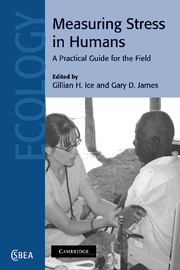Book contents
- Frontmatter
- Contents
- Contributors
- Foreword by Geoffrey A. Harrison
- Part I General principles
- Part II Measuring stress responses
- Part III Practical issues in studying stress
- 8 Measuring stress in special populations
- 9 Study design and data analysis
- 10 Protection of human subjects in stress research: an investigator's guide to the process
- 11 Epilog: summary and future directions
- Index
- References
8 - Measuring stress in special populations
Published online by Cambridge University Press: 11 September 2009
- Frontmatter
- Contents
- Contributors
- Foreword by Geoffrey A. Harrison
- Part I General principles
- Part II Measuring stress responses
- Part III Practical issues in studying stress
- 8 Measuring stress in special populations
- 9 Study design and data analysis
- 10 Protection of human subjects in stress research: an investigator's guide to the process
- 11 Epilog: summary and future directions
- Index
- References
Summary
In the introduction to this volume, Ice and James refer to “practical considerations” as an important component when selecting a measure of stress. This chapter will discuss some practical considerations in detail in the consideration of stress measurement in reproductive age women, children, older populations, and in non-clinical settings. Selection of culturally relevant questionnaires and interview techniques in field settings are discussed in detail elsewhere in this volume, so this chapter will focus on the collection of physiological markers of stress in non-clinical settings. Current research has suggested new areas of interest and new biological markers of relevance in these special populations. Some practical considerations discussed in this chapter include selection of relevant and appropriate biological markers of stress in special populations and logistical considerations associated with collecting biological markers in non-clinical settings. Many of these factors can impact compliance rates, the number of individuals who will agree to participate and successfully complete the study as well as the acceptability of biological samples for laboratory analysis.
Stress and reproducing women
Stress and reproductive function
According to the demographer Bongaarts (1983), there are seven “proximate determinants” of fertility that mediate all other variables (e.g. social, economic, and cultural) that control the length of birth intervals. Stress has been suggested to impact reproduction through all of Bongaart's proximate determinants of fertility (Bongaarts, 1983). Consequences of Sympathetic Adrenal Medullary System (SAMS) and/or Hypothalamic Pituitary Adrenal (HPA) axis activation have been identified as interfering with exposure factors (i.e. age at menarche, coital frequency), waiting time to conception (reproductive cycles, ovulation), pregnancy loss, and gestation length (parturition).
- Type
- Chapter
- Information
- Measuring Stress in HumansA Practical Guide for the Field, pp. 211 - 225Publisher: Cambridge University PressPrint publication year: 2006



